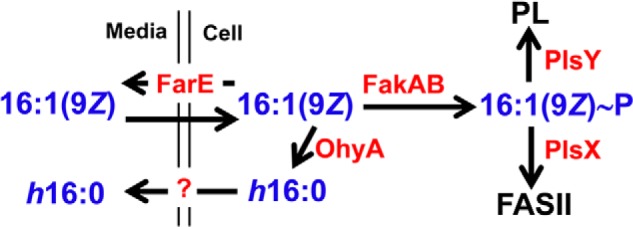Figure 8.

Model illustrating the active defense mechanisms used by S. aureus to detoxify antimicrobial fatty acids. Antimicrobial fatty acids (16:1(9Z)) are produced by the skin to block the growth of S. aureus and are thought to enter the cell by flipping across the membrane bilayer. S. aureus deploys three active countermeasures to combat 16:1(9Z); 1) SaOhyA hydroxylates and inactivates 16:1(9Z) to h16:0, which then exits the cell into the medium by an unknown mechanism; 2) FarE is a fatty acid efflux pump that protects against antimicrobial fatty acid by returning them to the medium (19); and 3) 16:1(9Z) can also be inactivated by incorporation into phospholipid by the PlsX and PlsY enzymes. The data show that most of the 16:1(9Z) incorporated into phospholipid (PL) is first converted to acyl-ACP by PlsX and elongated by FASII before it is utilized for phospholipid synthesis by PlsY (12). Human skin produces 16:1(6Z), which is not an SaOhyA substrate, to circumvent the OhyA-dependent resistance mechanism.
